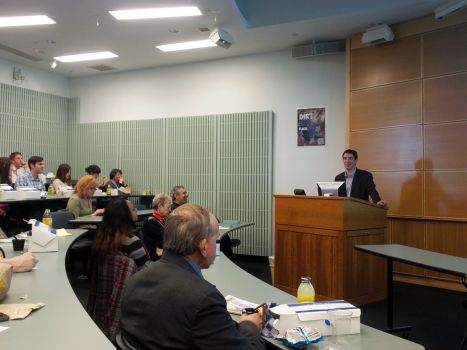Dr. Eric Klinenberg, professor of sociology and communication at New York University, presented at the Annenberg School for Communication at the University of Pennsylvania on Friday, Feb. 17. Accompanied by the recent publication of his newest book, “Going Solo: The Extraordinary Rise and Surprising Appeal of Living Alone,” Klinenberg’s lecture examined the social habits and environments of those who he refers to as “singletons,” members of single-person households.
According to Klinenberg, the increase in living alone over the past 60 years is “the biggest modern social change that we’ve failed to name or identify.” He cites the largest demographic of singletons as middle-aged adults between the ages of 35 and 65, totaling about 16 million people in the United States.
“Today, about 50 percent of American adults are single,” Klinenberg said. “And 28 percent of all households are one-person households.”
With this sharp increase in living alone, he says that the singletons’ subsequent rise in social isolation is something to be worried about, although the impact is, according to him, insignificant.
Citing “Alone Together” by Sherry Turkle, a technology and social specialist at MIT, Klinenberg says that the main argument in her book revolves around the concept of social media “turning us into loners and isolants who are fundamentally dissatisfied with the way our lives work.”
Countering this, however, Klinenberg states that “living alone is a social experience.” Recent studies have shown that people who live alone are more likely to be social with neighbors and to volunteer at city organizations in comparison to people who are married.
Klinenberg also drew attention to the older American singletons, claiming that they too are more likely to socialize with friends and neighbors than married Americans in their similar age range.
“Despite the relatively large amounts of time spent alone, they’re more connected than other people their age,” Klinenberg explained.
Klinenberg has come to see this sudden upheaval from the family household as a social experiment, an adaptation and a “way of being creative about what it means to live a life.”
“If you think about it, we have 200,000 years as a species of living together, collectively,” Klinenberg said. “And we have about, let’s say 50 or 60 years of experience living alone.”
One perspective he deemed worthy of taking on the matter was that of an economist. From an economist’s perspective, Klinenberg says two main things are taken into consideration about those who live alone: first, their level of prosperity or income, since it costs more to live alone and secondly, the welfare state of the individual’s location, which he sees as providing a sense of security essential for anyone living alone.
“Our independence has been made possible by our interdependence,” Klinenberg said. “What we call social security, or a pension, or healthcare, or homecare, or subsidized housing, makes it possible to live alone.”
Klinenberg also sees the rising emergence of one-person households as beneficial to the economy.
“The rise of the singleton has been a tremendous economic boost for our cities,” Klinenberg said. “People who live alone go out and spend more money per capita and have more disposable income than people married and with children.”
What, then, is the actual point of living alone? Why are all of these people doing it?
The furthered urbanization of cities, Klinenberg says, is the main cause of this trend of living alone. He explains that cities give rise to “subcultures,” allowing the individual to “express parts of [themselves] that could have been latent in [them] in a small town or rural area.”
Largely, he says, this increase is about individuality, freedom, personal control and self-realization.
As for how social media plays a role, he says that its presence within the hands of today’s “digital natives” can prove beneficial.
“As people have experiences earlier in life with things like Facebook and they get older themselves, they will have another set of tools for getting connected, which will change the experience of aging,” Klinenberg said.



